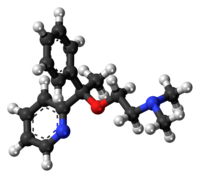多西拉敏
 | |
 | |
| 临床资料 | |
|---|---|
| 商品名 | Unisom, Vicks配方44 (加右美沙芬,成为复方药), 其他 |
| AHFS/Drugs.com | Monograph |
| MedlinePlus | a682537 |
| 怀孕分级 |
|
| 给药途径 | 口服给药 |
| ATC码 |
|
| 法律规范状态 | |
| 法律规范 | |
| 药物动力学数据 | |
| 生物利用度 | 口服给药: 24.7%[1] 鼻腔给药: 70.8%[1] |
| 药物代谢 | 肝脏 (酵素CYP2D6、CYP1A2及CYP2C9)[2] |
| 生物半衰期 | 10–12小时 (范围7–15小时)[2][3][4] |
| 排泄途径 | 尿 (60%), 粪便 (40%)[5] |
| 识别信息 | |
| |
| CAS号 | 469-21-6 |
| PubChem CID | |
| IUPHAR/BPS | |
| DrugBank | |
| ChemSpider | |
| UNII | |
| KEGG | |
| ChEBI | |
| ChEMBL | |
| CompTox Dashboard (EPA) | |
| ECHA InfoCard | 100.006.742 |
| 化学信息 | |
| 化学式 | C17H22N2O |
| 摩尔质量 | 270.38 g·mol−1 |
| 3D模型(JSmol) | |
| |
| |
多西拉敏(英语:Doxylamine)以Unisom(优尼舒)等品牌于市面销售,是种抗组织胺药,用于治疗失眠和过敏。它也与吡哆醇(维生素B6)结合使用,用于治疗孕妇的孕吐。多西拉敏是非处方药,夜间止咳药(例如奈奎尔,NyQuil,也称舒必利)以及含有乙酰氨酚和可待因的镇痛药中会含有此种成分,以帮助睡眠。该药物透过口服的方式给药。
使用多西拉敏的副作用有头晕、嗜睡、昏沉和口干等。[6][4]此药物是种抗组织胺药,特别是组织胺中的组织胺H1受体拮抗剂,且在较小程度上是抗胆碱剂,特别是毒蕈碱型乙酰胆碱受体 M1至毒蕈碱型乙酰胆碱受体M5的受体拮抗剂。它是最早一代的H1 拮抗剂,可穿过血脑屏障进入大脑,产生中枢神经系统介导的镇静和安眠作用。
多西拉敏于1948年或1949年首次受到描述。[7]包括多西拉敏在内的几种最早一代抗组织胺药是目前全球最广为使用的安眠药物。[8]它也是一种有效的抗胆碱剂,表示在高剂量剂的情况下有致谵妄剂的作用。[9]由于其镇静和致谵妄作用而有一些娱乐性用药的案例。
医疗用途
多西拉敏可用于治疗打喷嚏、流鼻水、流泪、荨麻疹、皮疹、发痒和其他感冒或过敏症状。也被用作短期治疗失眠之用。[10]
失眠
最早一代镇静用抗组织胺苯海拉明、多塞平、多西拉敏和扑尔敏是最受广泛使用的预防和治疗失眠的药物。[8]截至2004年,多西拉敏和苯海拉明(均为非处方药)是最常用于短期治疗失眠的药物。[11]美国睡眠医学学会于2008年和2017年以"因相对缺乏疗效和安全性数据"的理由而不建议使用非处方抗组织胺药物以治疗慢性失眠。[12][13]学会的指南版本提出苯海拉明,却没明确包含或提及多西拉敏。[12][13]于2015年对包括多西拉敏在内的非处方助眠剂进行的系统性回顾结果,几乎没证据显示多西拉敏有治疗失眠的效果。[4]
于2022年发表的一项关于治疗失眠药物的重大系统性回顾与间接性网状统合分析,发现多西拉敏与安慰剂治疗失眠4周后的效应值(标准化平均差(SMD))为0.47(95%置信区间,范围0.06至0.89)。[14]证据等级为中等。[14]并无多西拉敏长期治疗(3个月)方面的数据。[14]用来与多西拉敏比较的两种镇静药物 - 多塞平和舒眠通(两者均为三环抗抑郁药)与安慰剂治疗失眠在4周时的效应值分别为0.30(95%置信区间,范围–0.05至0.64 )(证据品质非常低)和0.55(95%置信区间,范围–0.11至1.21)(证据品质非常低)。[14]
用于安眠的多西拉敏剂量范围为5至50毫克,其中以25毫克最为常见。[15][16][17][18]
孕吐
多西拉敏与维生素B6结合制成吡哆醇/多西拉敏(复方药物),用于治疗孕吐(因怀孕而导致的恶心和呕吐)。[19][20][21]它是美国食品药物管理局FDA)唯一批准用于治疗孕吐的药物。[19][20]
药物形式
|
参见:吡哆醇/多西拉敏 |
多西拉敏在医学上以琥珀酸多西拉敏(多西拉敏的琥珀酸盐)形式供应,可单独使用(商品名Decapryn、Doxy-Sleep-Aid、Unisom),也可与吡哆醇(维生素B6的一种形式)联合使用(商品名Bendectin、Bonjesta及Diclegis)。[22]多西拉敏可单独作为速释口服锭剂使用(含有25毫克琥珀酸多西拉敏)。[22]先前也有含12.5毫克琥珀酸多西拉敏的口服锭剂以及含有25毫克琥珀酸多西拉敏的口服胶囊,但已停产。[22]多西拉敏和吡哆醇的组合以缓释和延迟释放口服片剂两种形式提供,其中含有10至20毫克琥珀酸多西拉敏,及10至20毫克盐酸吡哆醇。[22]多西拉敏可用非处方药形式购得,而多西拉敏与吡哆醇的复方剂则为处方药。[22]多西拉敏也存于非处方夜间止咳药中,例如NyQuil Cold & Flu(含有乙酰氨酚、琥珀酸多西拉敏6.25至12.5毫克,以及右美沙芬(一种镇咳药物)),其中多西拉敏作镇静之用。[23][24]
用药禁忌
副作用
多西拉敏的副作用包括头晕、嗜睡和口干等。[4]多西拉敏是一种强效抗胆碱剂,具有此类药物常见的副作用有视力模糊、口干、便秘、共济失调、尿潴留、意识错乱和谵妄。[18][6]
由于多西拉敏的生物半衰期相对较长(10-12小时),用作安眠药时,在第二天会出现的副作用有镇静、嗜睡、昏沉、口乾和疲倦。[26][18]这可被描述为"宿醉效应"。[18]苯海拉明比多西拉敏的生物半衰期为短(4-8小时),此方面会比多西拉敏较具安眠的优势。[27]
多西拉敏等抗组织胺药最初作镇静用,但重复使用会产生耐受性,停药后可能有反弹效应。[6][28]
偶有使用多西拉敏导致昏迷和横纹肌溶解症的案例报告。[2]使用苯海拉明尚无此种报导。[2]
对小家鼠和大鼠的多西拉敏致癌性研究,在肝癌和甲状腺癌方面,特别是在小家鼠身上产生积极的结果。[29]该药物对人类的致癌性尚未得到充分研究,国际癌症研究机构将该药物列为"无法将其对人类的致癌性进行分类"。[30]
连续和/或累积使用抗胆碱剂(包括最早一代抗组织胺,如多西拉敏)与老年人认知能力下降和失智症的风险较高有关联。[31][32]
过量
健康成年人服用多西拉敏通常不会产生安全问题。成人思觉失调症患者服用多西拉敏持续6个月,剂量高达1,600毫克/天,仅有微量毒性出现。[33]对人的半数致死量 (LD50) 估计为 50–500毫克/公斤。[34]过量服用的症状可能包括口干、瞳孔放大、失眠、夜惊、欣快感觉、幻觉、癫痫发作、横纹肌溶解和死亡。[35]有多西拉敏过量致死的报导。症状特征是昏迷、全身强直阵挛发作、癫痫发作和心搏停止。儿童出现心搏停止的风险似乎很高。有儿童因摄取超过1.8毫克/公斤而中毒的报导。一名3岁儿童在摄取1,000毫克琥珀酸多西拉敏,于18小时后死亡。[5]在极少数情况下,服用过量会导致横纹肌溶解和急性肾损伤。[36]
药理学
药效学
| 发生所在 | 结合亲和力 (纳摩尔) | 物种 | 参考文献 |
|---|---|---|---|
| 血清素转运体 | >10,000 | 人类 | [38] |
| 正肾上腺素转运体 | >10,000 | 人类 | [38] |
| 多巴胺转运体 | >10,000 | 人类 | [38] |
| 5-HT2A受体 | >10,000 | 人类 | [38] |
| 5-HT2C受体 | >10,000 | 人类 | [38] |
| Alpha-1B肾上腺能受体 | >10,000 | 人类 | [38] |
| Alpha-2A肾上腺能受体 | >10,000 | 人类 | [38] |
| Alpha-2B肾上腺能受体 | >10,000 | 人类 | [38] |
| Alpha-2C肾上腺能受体 | >10,000 | 人类 | [38] |
| 组织胺H1受体 | 42 | 人类 | [38] |
| 组织胺H2受体 | 无资料 | 无资料 | 无资料 |
| 组织胺H3受体 | >10,000 | 人类 | [38] |
| 组织胺H4受体 | 无资料 | 无资料 | 无资料 |
| 乙酰胆碱肌肽受体M1 | 490 | 人类 | [38] |
| 乙酰胆碱肌肽受体M2 | 2,100 | 人类 | [38] |
| 乙酰胆碱肌肽受体M3 | 650 | 人类 | [38] |
| 乙酰胆碱肌肽受体M4 | 380 | 人类 | [38] |
| 乙酰胆碱肌肽受体M5 | 180 | Human | [38] |
| 结合亲和力(Fi)纳摩尔(nM)的数值越小,表示结合亲和力越强。 | |||
多西拉敏主要作为组织胺H1受体的拮抗剂(即反向激动剂)。[39][38]这种作用是其有抗组织胺和镇静特性的缘故。[39][38]多西拉敏在较小程度上有毒蕈碱乙酰胆碱受体拮抗剂作用,[39][38]高剂量使用会导致谵妄发生。[39][38]
药物动力学
多西拉敏以口服摄取时,生物利用度为24.7%,鼻腔给药的生物利用度为70.8%。[1]多西拉敏的最大血药浓度(Tmax)为1.5至2.5小时。[2]生物半衰期为10至12小时(范围为7至15小时)。[2][3][4]多西拉敏主要在肝脏中经由细胞色素P450酵素CYP2D6、CYP1A2和CYP2C9所代谢。[2][40]主要代谢产物为N-去甲基多西拉明、N,N-二去甲基多西拉明和多西拉敏N-氧化物。[41]透过尿液可消除60%的多西拉敏,其余的40%经粪便排出。[5]

化学
多西拉敏是乙醇胺抗组织胺中的一种。[8]其他同组的抗组织胺药物包括溴苯海拉明、卡比沙明、茶苯海明、奥芬那君和苯托沙明。[8][42]
历史
多西拉敏是最早一代抗组织胺药,由Nathan Sperber及其同事合成,并于1948年或1949年首次提出报告。[43][7][44]奈奎尔(NyQui) 自1966年以来一直含有这种抗组织胺成分。[43]
商品名为Bendectin的药物是多西拉敏、吡哆醇和双环维林(一种抗胆碱能解痉药)组成的复方药,于1956年上市,用于治疗孕吐。[45]本产品于1976年重新配制,不再含有双环维林。[45]此重新配制的产品因制造商担心与据称先天性肢体缺陷有关联,于1983年自愿停产。[45]然而此担忧并未得到研究的支持。[19][20]2013年,多西拉敏/吡哆醇以Diclegis品牌重新引入美国。[19][20]该复方药自1979年以来一直在加拿大销售,未曾撤出。[19][20]
社会与文化
配方
多西拉敏主要以琥珀酸盐(琥珀酸多西拉敏)形式使用。
- 它是奈奎尔中的镇静成分(通常与右美沙芬及乙酰氨酚联合使用)。
- 在共和联邦国家中,如澳大利亚、加拿大、南非和英国,多西拉敏之外,尚添加扑热息痛(即乙酰氨酚)和可待因制成,商品名为Dolased、Propain Plus、Syndol或Mersyndol,可用于治疗紧缩型头痛和其他类型的疼痛。
- 琥珀酸多西拉敏用于一般非处方安眠药,品牌为Somnil(南非)、Dozile、Donormyl、Lidène(法国,俄罗斯)、Dormidina(西班牙,葡萄牙)、Restavit、Unisom-2、Sominar(泰国 )、Sleep Aid(通用名药物,澳大利亚)和 Dorminox(波兰)。
- 美国:
- 琥珀酸多西拉敏是许多不同名称的非处方安眠药中的活性成分。
- 琥珀酸多西拉敏和吡哆醇是Diclegis的成分,于2013年4月获得FDA批准,成为唯一可用于治疗孕吐的药物,[46]具有A级妊娠安全评级(无风险证据)。
- 加拿大:
- 琥珀酸多西拉敏和吡哆醇是Diclectin的成分,用于预防孕吐。
- 它还与吡哆醇和叶酸组合使用,品牌名称为Evanorm(由Ion Healthcare销售)。
- 印度
- 多西拉敏制剂通常与吡哆醇(可能也含有叶酸)组合使用。而导致孕妇的使用受到限制。
参见
- ^ 1.0 1.1 1.2 Pelser A, Müller DG, du Plessis J, du Preez JL, Goosen C. Comparative pharmacokinetics of single doses of doxylamine succinate following intranasal, oral and intravenous administration in rats. Biopharmaceutics & Drug Disposition. September 2002, 23 (6): 239–244. PMID 12214324. S2CID 32126626. doi:10.1002/bdd.314.
- ^ 2.0 2.1 2.2 2.3 2.4 2.5 2.6 Kryger MH, Roth T, Dement WC. Principles and Practice of Sleep Medicine E-Book. Elsevier Health Sciences. 2010-11-01: 925. ISBN 978-1-4377-2773-9.
- ^ 3.0 3.1 3.2 Allison M, Hale C. A Phase I Study of the Pharmacokinetics and Pharmacodynamics of Intranasal Doxylamine in Subjects with Chronic Intermittent Sleep Impairment. Drugs in R&D. June 2018, 18 (2): 129–136. PMC 5995792
 . PMID 29671128. doi:10.1007/s40268-018-0232-1.
. PMID 29671128. doi:10.1007/s40268-018-0232-1.
- ^ 4.0 4.1 4.2 4.3 4.4 Culpepper L, Wingertzahn MA. Over-the-Counter Agents for the Treatment of Occasional Disturbed Sleep or Transient Insomnia: A Systematic Review of Efficacy and Safety. The Primary Care Companion for CNS Disorders. 2015, 17 (6). PMC 4805417
 . PMID 27057416. doi:10.4088/PCC.15r01798.
. PMID 27057416. doi:10.4088/PCC.15r01798.
- ^ 5.0 5.1 5.2 New Zealand Datasheet: Doxylamine Succinate (PDF). Medsafe, New Zealand Medicines and Medical Devices Safety Authority. 2008-07-16. (原始内容存档于2016-03-22).
- ^ 6.0 6.1 6.2 Neubauer DN. The evolution and development of insomnia pharmacotherapies. Journal of Clinical Sleep Medicine. August 2007, 3 (5 Suppl): S11–S15. PMC 1978321
 . PMID 17824496. doi:10.5664/jcsm.26930.
. PMID 17824496. doi:10.5664/jcsm.26930.
- ^ 7.0 7.1 Fischer J, Ganellin CR. Analogue-based Drug Discovery. John Wiley & Sons. 2006: 546. ISBN 9783527607495.
- ^ 8.0 8.1 8.2 8.3 Simons FE, Simons KJ. Histamine and H1-antihistamines: celebrating a century of progress. The Journal of Allergy and Clinical Immunology. December 2011, 128 (6): 1139–1150.e4. PMID 22035879. doi:10.1016/j.jaci.2011.09.005
 .
.
- ^ Doxylamine - PsychonautWiki.
- ^ Doxylamine: MedlinePlus Drug Information.
- ^ Ringdahl EN, Pereira SL, Delzell JE. Treatment of primary insomnia. The Journal of the American Board of Family Practice. 2004, 17 (3): 212–219. PMID 15226287. doi:10.3122/jabfm.17.3.212
 .
.
- ^ 12.0 12.1 Schutte-Rodin S, Broch L, Buysse D, Dorsey C, Sateia M. Clinical guideline for the evaluation and management of chronic insomnia in adults. Journal of Clinical Sleep Medicine. October 2008, 4 (5): 487–504. PMC 2576317
 . PMID 18853708. doi:10.5664/jcsm.27286.
. PMID 18853708. doi:10.5664/jcsm.27286.
- ^ 13.0 13.1 Sateia MJ, Buysse DJ, Krystal AD, Neubauer DN, Heald JL. Clinical Practice Guideline for the Pharmacologic Treatment of Chronic Insomnia in Adults: An American Academy of Sleep Medicine Clinical Practice Guideline. Journal of Clinical Sleep Medicine. February 2017, 13 (2): 307–349. PMC 5263087
 . PMID 27998379. doi:10.5664/jcsm.6470.
. PMID 27998379. doi:10.5664/jcsm.6470.
- ^ 14.0 14.1 14.2 14.3 De Crescenzo F, D'Alò GL, Ostinelli EG, Ciabattini M, Di Franco V, Watanabe N, et al. Comparative effects of pharmacological interventions for the acute and long-term management of insomnia disorder in adults: a systematic review and network meta-analysis. Lancet. July 2022, 400 (10347): 170–184. PMID 35843245. S2CID 250536370. doi:10.1016/S0140-6736(22)00878-9
 .
.
- ^ Perry PJ. Psychotropic Drug Handbook. Lippincott Williams & Wilkins. 2007. ISBN 9780781762731.
- ^ Dupuis G, Vaugeois JM. [The interesting anti-H1 effects in maintenance insomnia: A reflection on the comparative advantages of doxylamine and doxepin] [The interesting anti-H1 effects in maintenance insomnia: A reflection on the comparative advantages of doxylamine and doxepin]. L'Encephale. February 2020, 46 (1): 80–82. PMID 30879783. S2CID 151085176. doi:10.1016/j.encep.2019.01.006
 (法语).
(法语).
- ^ Lie JD, Tu KN, Shen DD, Wong BM. Pharmacological Treatment of Insomnia. P & T. November 2015, 40 (11): 759–771. PMC 4634348
 . PMID 26609210.
. PMID 26609210.
- ^ 18.0 18.1 18.2 18.3 Shirley DW, Sterrett J, Haga N, Durham C. The therapeutic versatility of antihistamines: A comprehensive review. The Nurse Practitioner. February 2020, 45 (2): 8–21. PMID 31913218. S2CID 210086511. doi:10.1097/01.NPR.0000651112.76528.ed
 .
.
- ^ 19.0 19.1 19.2 19.3 19.4 Nuangchamnong N, Niebyl J. Doxylamine succinate-pyridoxine hydrochloride (Diclegis) for the management of nausea and vomiting in pregnancy: an overview. International Journal of Women's Health. 2014, 6: 401–409. PMC 3990370
 . PMID 24748822. doi:10.2147/IJWH.S46653
. PMID 24748822. doi:10.2147/IJWH.S46653  .
.
- ^ 20.0 20.1 20.2 20.3 20.4 Madjunkova S, Maltepe C, Koren G. The delayed-release combination of doxylamine and pyridoxine (Diclegis®/Diclectin ®) for the treatment of nausea and vomiting of pregnancy. Paediatric Drugs. June 2014, 16 (3): 199–211. PMC 4030125
 . PMID 24574047. doi:10.1007/s40272-014-0065-5.
. PMID 24574047. doi:10.1007/s40272-014-0065-5.
- ^ Cada DJ, Demaris K, Levien TL, Baker DE. Doxylamine succinate/pyridoxine hydrochloride. Hospital Pharmacy. October 2013, 48 (9): 762–766. PMC 3857125
 . PMID 24421551. doi:10.1310/hpj4809-762.
. PMID 24421551. doi:10.1310/hpj4809-762.
- ^ 22.0 22.1 22.2 22.3 22.4 Drugs@FDA: FDA-Approved Drugs. accessdata.fda.gov. [2022-08-23].
- ^ VICKS NYQUIL COLD AND FLU - acetaminophen, dextromethorphan hydrobromide, and doxylamine succinate capsule, liquid filled. DailyMed. U.S. National Library of Medicine.
- ^ Nyquil Cold and Flu: Basics, Side Effects & Reviews.
- ^ Briggs GG, Freeman RK, Yaffe SJ. Drugs in Pregnancy and Lactation: A Reference Guide to Fetal and Neonatal Risk. Obstetric Medicine 2. Lippincott Williams & Wilkins. 2008: 89. ISBN 978-0-7817-7876-3. PMC 4989726
 . doi:10.1258/om.2009.090002.
. doi:10.1258/om.2009.090002. |issue=被忽略 (帮助) - ^ Avidan AY. Review of Sleep Medicine E-Book. Elsevier Health Sciences. 2017: 394. ISBN 978-0-323-47349-1.
- ^ Rutter P, Newby D. Community Pharmacy ANZ – eBook: Symptoms, Diagnosis and Treatment. Elsevier Health Sciences. 2015-09-11: 99. ISBN 978-0-7295-8345-9.
- ^ Stahl SM. Selective histamine H1 antagonism: novel hypnotic and pharmacologic actions challenge classical notions of antihistamines. CNS Spectrums. December 2008, 13 (12): 1027–1038. PMID 19179941. S2CID 6849261. doi:10.1017/s1092852900017089.
- ^ Doxylamine succinate (CAS 562-10-7) 互联网档案馆的存档,存档日期2012-05-01.. berkeley.edu.
- ^ DOXYLAMINE SUCCINATE. International Agency for Research on Cancer (IARC) – Summaries & Evaluations.
- ^ Gray SL, Anderson ML, Dublin S, Hanlon JT, Hubbard R, Walker R, et al. Cumulative use of strong anticholinergics and incident dementia: a prospective cohort study. JAMA Internal Medicine. March 2015, 175 (3): 401–407. PMC 4358759
 . PMID 25621434. doi:10.1001/jamainternmed.2014.7663.
. PMID 25621434. doi:10.1001/jamainternmed.2014.7663.
- ^ Carrière I, Fourrier-Reglat A, Dartigues JF, Rouaud O, Pasquier F, Ritchie K, Ancelin ML. Drugs with anticholinergic properties, cognitive decline, and dementia in an elderly general population: the 3-city study. Archives of Internal Medicine. July 2009, 169 (14): 1317–1324. PMC 2933398
 . PMID 19636034. doi:10.1001/archinternmed.2009.229.
. PMID 19636034. doi:10.1001/archinternmed.2009.229.
- ^ Federal Register, Volume 43, Issues 114-121. Office of the Federal Register, National Archives and Records Service, General Services Administration. 1978: 25584. OCLC 1768512.
- ^ DOXYLAMINE SUCCINATE. hazard.com. 原始内容存档于2022-01-17.
- ^ Syed H, Som S, Khan N, Faltas W. Doxylamine toxicity: seizure, rhabdomyolysis and false positive urine drug screen for methadone. BMJ Case Reports. 17 March 2009, 2009 (90): 845. PMC 3028279
 . PMID 21686586. doi:10.1136/bcr.09.2008.0879.
. PMID 21686586. doi:10.1136/bcr.09.2008.0879.
- ^ Leybishkis B, Fasseas P, Ryan KF. Doxylamine overdose as a potential cause of rhabdomyolysis. The American Journal of the Medical Sciences. July 2001, 322 (1): 48–49. PMID 11465247. doi:10.1097/00000441-200107000-00009.
- ^ Roth BL, Driscol J. PDSP Ki Database. Psychoactive Drug Screening Program (PDSP). University of North Carolina at Chapel Hill and the United States National Institute of Mental Health. [2017-08-14].
- ^ 38.00 38.01 38.02 38.03 38.04 38.05 38.06 38.07 38.08 38.09 38.10 38.11 38.12 38.13 38.14 38.15 38.16 38.17 38.18 38.19 Krystal AD, Richelson E, Roth T. Review of the histamine system and the clinical effects of H1 antagonists: basis for a new model for understanding the effects of insomnia medications. Sleep Medicine Reviews. August 2013, 17 (4): 263–272. PMID 23357028. doi:10.1016/j.smrv.2012.08.001.
- ^ 39.0 39.1 39.2 39.3 Vande Griend JP, Anderson SL. Histamine-1 receptor antagonism for treatment of insomnia. Journal of the American Pharmacists Association. 2012, 52 (6): e210–e219. PMID 23229983. doi:10.1331/JAPhA.2012.12051.
- ^ Krystal AD. A compendium of placebo-controlled trials of the risks/benefits of pharmacological treatments for insomnia: the empirical basis for U.S. clinical practice. Sleep Medicine Reviews. August 2009, 13 (4): 265–274. PMID 19153052. doi:10.1016/j.smrv.2008.08.001.
- ^ Holder CL, Korfmacher WA, Slikker W, Thompson HC, Gosnell AB. Mass spectral characterization of doxylamine and its rhesus monkey urinary metabolites. Biomedical Mass Spectrometry. April 1985, 12 (4): 151–158. PMID 2861861. S2CID 6020605. doi:10.1002/bms.1200120403.
- ^ Kalpaklioglu F, Baccioglu A. Efficacy and safety of H1-antihistamines: an update. Anti-Inflammatory & Anti-Allergy Agents in Medicinal Chemistry. 2012, 11 (3): 230–237. PMID 23173575. doi:10.2174/1871523011202030230.
- ^ 43.0 43.1 Atta-ur-Rahman (编). Frontiers in Clinical Drug Research - Anti-Allergy Agents, Volume 3. Bentham Science Publishers. 11 July 2018: 30. ISBN 978-1-68108-337-7. OCLC 1048922805.
- ^ Sperber N, Papa D. Pyridyl-substituted alkamine ethers as antihistaminic agents. Journal of the American Chemical Society. March 1949, 71 (3): 887–890. PMID 18113525. doi:10.1021/ja01171a034.
- ^ 45.0 45.1 45.2 Briggs GG, Freeman RK, Yaffe SJ. Drugs in Pregnancy and Lactation: A Reference Guide to Fetal and Neonatal Risk 9. Lippincott Williams & Wilkins. 28 March 2012: 453. ISBN 978-1-4511-5359-0. OCLC 1232803849.
- ^ Slaughter SR, Hearns-Stokes R, van der Vlugt T, Joffe HV. FDA approval of doxylamine-pyridoxine therapy for use in pregnancy. The New England Journal of Medicine. March 2014, 370 (12): 1081–1083. PMID 24645939. doi:10.1056/NEJMp1316042
 .
.
| ||||||||||||||||||||||||||||||||||||||||||||||||||||||||||||||||||||||||||||||||||||||||||||||||||||||||||||||||||||||||||||||||||||||||||||||||||||||||||||||||||||||||||||||||||||||||||||||||||||
| ||||||||||||||||||||||||||||||||||||||||||||||||||||||||||||||||||||||||||||||||||||||||||||||||||||||||||||||||||
| |||||||||||||||||||||||||||||||||||||||||||||||||||||||||||||||
Text is available under the CC BY-SA 4.0 license; additional terms may apply.
Images, videos and audio are available under their respective licenses.
